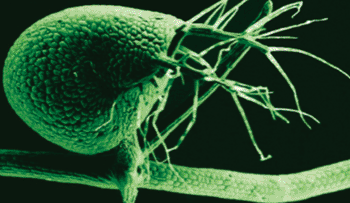Complex Plant Thrives with a Genome Purged of Noncoding DNA
|
By LabMedica International staff writers Posted on 27 May 2013 |

Image: Scanning electron micrograph of the bladder of Utricularia gibba, the carnivorous bladderwort plant (color added) (Photo courtesy of Enrique Ibarra-Laclette, Claudia Anahí Pérez-Torres, and Paulina Lozano-Sotomayor, Laboratorio Nacional de Genómica para la Biodiversidad, Mexico).

Image: Contributing author Dr. Victor Albert (Photo courtesy of the University of Buffalo).
Analysis of the genome of the carnivorous bladderwort plant, Utricularia gibba, revealed that this organism has drastically limited the amount of noncoding DNA while preserving all functional genes needed to regulate and integrate the processes required for the development and reproduction of a complex organism.
Functional genes—those encoding specific proteins—comprise only about 2% of the human genome while the rest of the genome consists of noncoding DNA. A recent series of papers suggested that the majority of noncoding DNA (about 80%) appeared to play a role in biochemical functions such as regulation and promotion of DNA conversion into RNA and ultimately into proteins.
A paper published in the May 12, 2013, online edition of the journal Nature questioned this role for noncoding DNA by observing that U. gibba thrives with practically no noncoding DNA.
An international team of genomic researchers based at Laboratorio Nacional de Genómica para la Biodiversidad (Irapuato, Mexico) and the University of Buffalo (NY, USA) reported that the U. gibba genome contains about 80 million DNA base pairs comprising about 28,500 genes. This genome is much smaller than those found in relatives like grape and tomato, which have much larger genomes that comprise 490 and 780 million base pairs, respectively. The difference in size results from a drastic reduction in noncoding DNA in the U. gibba genome.
“The big story is that only 3% of the bladderwort’s genetic material is so-called “junk” DNA,” said contributing author Dr. Victor Albert, professor of biological sciences at the University of Buffalo. “Somehow, this plant has purged most of what makes up plant genomes. What that says is that you can have a perfectly good multicellular plant with lots of different cells, organs, tissue types, and flowers, and you can do it without the junk. Junk is not needed.”
The extremely limited content of noncoding DNA in the U. gibba genome is particularly remarkable considering that the species has undergone three complete genome doublings since its evolutionary lineage split from that of the tomato. Thus, at three distinct times in the course of its evolution, the bladderwort’s genome doubled in size. “This surprisingly rich history of duplication, paired with the current small size of the bladderwort genome, is further evidence that the plant has been prolific at deleting nonessential DNA, but at the same time maintaining a functional set of genes similar to those of other plant species” said senior author Dr. Herrera-Estrella, professor of physiology and metabolic engineering of plants at Laboratorio Nacional de Genómica para la Biodiversidad.
Related Links:
Laboratorio Nacional de Genómica para la Biodiversidad
University of Buffalo
Functional genes—those encoding specific proteins—comprise only about 2% of the human genome while the rest of the genome consists of noncoding DNA. A recent series of papers suggested that the majority of noncoding DNA (about 80%) appeared to play a role in biochemical functions such as regulation and promotion of DNA conversion into RNA and ultimately into proteins.
A paper published in the May 12, 2013, online edition of the journal Nature questioned this role for noncoding DNA by observing that U. gibba thrives with practically no noncoding DNA.
An international team of genomic researchers based at Laboratorio Nacional de Genómica para la Biodiversidad (Irapuato, Mexico) and the University of Buffalo (NY, USA) reported that the U. gibba genome contains about 80 million DNA base pairs comprising about 28,500 genes. This genome is much smaller than those found in relatives like grape and tomato, which have much larger genomes that comprise 490 and 780 million base pairs, respectively. The difference in size results from a drastic reduction in noncoding DNA in the U. gibba genome.
“The big story is that only 3% of the bladderwort’s genetic material is so-called “junk” DNA,” said contributing author Dr. Victor Albert, professor of biological sciences at the University of Buffalo. “Somehow, this plant has purged most of what makes up plant genomes. What that says is that you can have a perfectly good multicellular plant with lots of different cells, organs, tissue types, and flowers, and you can do it without the junk. Junk is not needed.”
The extremely limited content of noncoding DNA in the U. gibba genome is particularly remarkable considering that the species has undergone three complete genome doublings since its evolutionary lineage split from that of the tomato. Thus, at three distinct times in the course of its evolution, the bladderwort’s genome doubled in size. “This surprisingly rich history of duplication, paired with the current small size of the bladderwort genome, is further evidence that the plant has been prolific at deleting nonessential DNA, but at the same time maintaining a functional set of genes similar to those of other plant species” said senior author Dr. Herrera-Estrella, professor of physiology and metabolic engineering of plants at Laboratorio Nacional de Genómica para la Biodiversidad.
Related Links:
Laboratorio Nacional de Genómica para la Biodiversidad
University of Buffalo
Latest BioResearch News
- Genome Analysis Predicts Likelihood of Neurodisability in Oxygen-Deprived Newborns
- Gene Panel Predicts Disease Progession for Patients with B-cell Lymphoma
- New Method Simplifies Preparation of Tumor Genomic DNA Libraries
- New Tool Developed for Diagnosis of Chronic HBV Infection
- Panel of Genetic Loci Accurately Predicts Risk of Developing Gout
- Disrupted TGFB Signaling Linked to Increased Cancer-Related Bacteria
- Gene Fusion Protein Proposed as Prostate Cancer Biomarker
- NIV Test to Diagnose and Monitor Vascular Complications in Diabetes
- Semen Exosome MicroRNA Proves Biomarker for Prostate Cancer
- Genetic Loci Link Plasma Lipid Levels to CVD Risk
- Newly Identified Gene Network Aids in Early Diagnosis of Autism Spectrum Disorder
- Link Confirmed between Living in Poverty and Developing Diseases
- Genomic Study Identifies Kidney Disease Loci in Type I Diabetes Patients
- Liquid Biopsy More Effective for Analyzing Tumor Drug Resistance Mutations
- New Liquid Biopsy Assay Reveals Host-Pathogen Interactions
- Method Developed for Enriching Trophoblast Population in Samples
Channels
Clinical Chemistry
view channel
Carbon Nanotubes Help Build Highly Accurate Sensors for Continuous Health Monitoring
Current sensors can measure various health indicators, such as blood glucose levels, in the body. However, there is a need to develop more accurate and sensitive sensor materials that can detect lower... Read more
Paper-Based Device Boosts HIV Test Accuracy from Dried Blood Samples
In regions where access to clinics for routine blood tests presents financial and logistical obstacles, HIV patients are increasingly able to collect and send a drop of blood using paper-based devices... Read moreMolecular Diagnostics
view channel
D-Dimer Testing Can Identify Patients at Higher Risk of Pulmonary Embolism
Pulmonary embolism (PE) is a commonly suspected condition in emergency departments (EDs) and can be life-threatening if not diagnosed correctly. Achieving an accurate diagnosis is vital for providing effective... Read more
New Biomarkers to Improve Early Detection and Monitoring of Kidney Injury
Drug-induced kidney injury, also known as nephrotoxicity, is a prevalent issue in clinical practice, occurring when specific medications at certain doses cause damage to the kidneys. Nephrotoxicity can... Read moreHematology
view channel
New Scoring System Predicts Risk of Developing Cancer from Common Blood Disorder
Clonal cytopenia of undetermined significance (CCUS) is a blood disorder commonly found in older adults, characterized by mutations in blood cells and a low blood count, but without any obvious cause or... Read more
Non-Invasive Prenatal Test for Fetal RhD Status Demonstrates 100% Accuracy
In the United States, approximately 15% of pregnant individuals are RhD-negative. However, in about 40% of these cases, the fetus is also RhD-negative, making the administration of RhoGAM unnecessary.... Read moreImmunology
view channel
Post-Treatment Blood Test Could Inform Future Cancer Therapy Decisions
In the ongoing advancement of personalized medicine, a new study has provided evidence supporting the use of a tool that detects cancer-derived molecules in the blood of lung cancer patients years after... Read more
Cerebrospinal Fluid Test Predicts Dangerous Side Effect of Cancer Treatment
In recent years, cancer immunotherapy has emerged as a promising approach where the patient's immune system is harnessed to fight cancer. One form of immunotherapy, called CAR-T-cell therapy, involves... Read more
New Test Measures Preterm Infant Immunity Using Only Two Drops of Blood
Preterm infants are particularly vulnerable due to their organs still undergoing development, which can lead to difficulties in breathing, eating, and regulating body temperature. This is especially true... Read more
Simple Blood Test Could Help Choose Better Treatments for Patients with Recurrent Endometrial Cancer
Endometrial cancer, which develops in the lining of the uterus, is the most prevalent gynecologic cancer in the United States, affecting over 66,000 women annually. Projections indicate that in 2025, around... Read moreMicrobiology
view channel
Breakthrough Diagnostic Technology Identifies Bacterial Infections with Almost 100% Accuracy within Three Hours
Rapid and precise identification of pathogenic microbes in patient samples is essential for the effective treatment of acute infectious diseases, such as sepsis. The fluorescence in situ hybridization... Read more
Innovative ID/AST System to Help Diagnose Infectious Diseases and Combat AMR
Each year, 11 million people across the world die of sepsis out of which 1.3 million deaths are due to antibiotic-resistant bacteria. The burden of antimicrobial resistance (AMR) continues to weigh heavily,... Read more
Gastrointestinal Panel Delivers Rapid Detection of Five Common Bacterial Pathogens for Outpatient Use
Acute infectious gastroenteritis results in approximately 179 million cases each year in the United States, leading to a significant number of outpatient visits and hospitalizations. To address this, a... Read morePathology
view channel
AI Model Predicts Patient Response to Bladder Cancer Treatment
Each year in the United States, around 81,000 new cases of bladder cancer are diagnosed, leading to approximately 17,000 deaths annually. Muscle-invasive bladder cancer (MIBC) is a severe form of bladder... Read more
New Laser-Based Method to Accelerate Cancer Diagnosis
Researchers have developed a method to improve cancer diagnostics and other diseases. Collagen, a key structural protein, plays various roles in cell activity. A novel multidisciplinary study published... Read more
New AI Model Predicts Gene Variants’ Effects on Specific Diseases
In recent years, artificial intelligence (AI) has greatly enhanced our ability to identify a vast number of genetic variants in increasingly larger populations. However, up to half of these variants are... Read more
Powerful AI Tool Diagnoses Coeliac Disease from Biopsy Images with Over 97% Accuracy
Coeliac disease is an autoimmune disorder triggered by the consumption of gluten, causing symptoms such as stomach cramps, diarrhea, skin rashes, weight loss, fatigue, and anemia. Due to the wide variation... Read moreTechnology
view channel
Smartphones Could Diagnose Diseases Using Infrared Scans
Rapid advancements in technology may soon make it possible for individuals to bypass invasive medical procedures by simply uploading a screenshot of their lab results from their phone directly to their doctor.... Read more
Novel Sensor Technology to Enable Early Diagnoses of Metabolic and Cardiovascular Disorders
Metabolites are critical compounds that fuel life's essential functions, playing a key role in producing energy, regulating cellular activities, and maintaining the balance of bodily systems.... Read more
3D Printing Breakthrough Enables Large Scale Development of Tiny Microfluidic Devices
Microfluidic devices are diagnostic systems capable of analyzing small volumes of materials with precision and speed. These devices are used in a variety of applications, including cancer cell analysis,... Read moreIndustry
view channel





















